 |
 |
 |
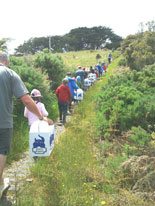 |
|
© Courtesy of Brent and Kari Beaven |
|
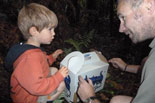 |
|
© Courtesy of Brent and Kari Beaven |
|
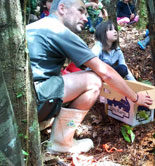 |
|
© Courtesy of Brent and Kari Beaven |
|
 |
|
© Courtesy of Brent and Kari Beaven |
|
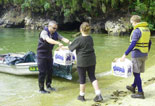 |
|
© Courtesy of Brent and Kari Beaven |
|
http://blog.doc.govt.nz/tag/stewart-island/
Stewart IslandRobins have been returned to one of their key habitats on Stewart Island, thanks to the sanctuary offered by the Dancing Star Foundation's former preserve. A partnership approach to conservation, involving the New Zealand government's Department of Conservation (DOC), New Zealand's largest airline, Air New Zealand, the school charged with teaching the island's next generation, Halfmoon Bay School, local Maori iwi, and the Dancing Star Foundation had created this ideal opportunity.
The Stewart Island Robin, Petroica australis Rakiura, is an endemic sub-species of the New Zealand Robin. It occurs only on Stewart Island and its small, surrounding islands. The species is in decline, having been extirpated from the main podocarp forests of Stewart Island, and surviving only in a flood-prone valley floor amongst manuka scrub.
In 2000, Stewart Island Robins were established on Ulva Island, a sanctuary for many endemic species, in a similar translocation to this one. They have since flourished in this environment, which is as close to "pristine" as New Zealand might once have been.
In December 2012, 28 juvenile Stewart Island Robins were caught by three native bird specialists, from sites around Ulva Island. The birds were carefully selected by a PhD student working with this population, to be at the optimum age for translocation, in particular for their establishment and recruitment to the new population, based on the collective experience from previous New Zealand robin translocations. They were banded with metal and colour bands, measured, weighed and small genetic and disease screening samples were taken. The birds were then placed in individual boxes designed specifically for their transportation and boated to the entrance to the preserve.
Local iwi representatives, Halfmoon Bay School children, teachers and parents, volunteers and Department of Conservation staff met the birds and helped to carry them through the dense forest to a site selected for their release. A mihi (welcome) and karakia (prayer) were sung for the birds before they were set free into their new home by the students, under the supervision of DOC staff.
In a moving display, a small family group of titi pounamu Acanthisitta chloris chloris, a species moved to the sanctuary for their protection only four years prior, which are now thriving throughout the entire forest, arrived at the site and stayed for the duration of the release ceremony, as if to demonstrate the significance and the opportunity being provided for these birds and their future generations.
In January 2013, a further 29 robins were translocated to reinforce this first group and ensure a sound, diverse genetic foundation for the new population. The birds were monitored throughout the coming year and into their first breeding season.
Moving this charismatic and territorial bird to the safety of the Dancing Star Foundation's preserve not only provided a safe refuge for another population to grow, it was also the first step in re-establishing the species around the neighbouring “Great Walk”, the Rakiura Track, and around the island's one township, Oban, the entranceway to the Rakiura National Park. Their presence will encourage more people to understand and care about the preservation of vulnerable local species. As of November, 2017, the predator-proof fenced area was free of the introduced threats to their survival, such as rats, possums and wild cats and, at 178 hectares in size, provided a sanctuary for many of New Zealand's endemic species.
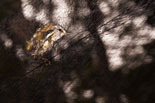 |
|
Titipounamou caught in a mist net on Ulva Island. © Fraser Crichton |
|
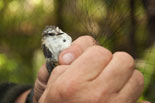 |
|
Simon Fordham releasing a titipounamu from a mist net. © Fraser Crichton |
|
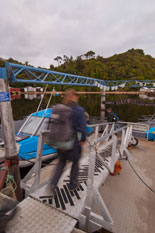 |
|
Kari Beaven boarding the water taxi to Ulva Island. © Fraser Crichton |
|
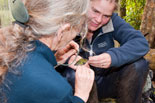 |
|
Morag Fordham taking a feather from a rifleman for DNA sampling. © Fraser Crichton |
|
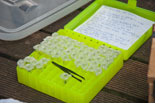 |
|
A DNA sample is taken from every bird banded. © Fraser Crichton |
|
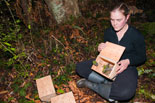 |
|
Kari Beaven releasing titipounamu at their new home on Stewart Island/Rakiura. © Fraser Crichton |
|
In mid-August 2008, the first two bird translocations were made onto the DSF Ecological Preserve, with the help of some 20 volunteers, the Stewart Island Rakiura Community and Environment Trust and the Department of Conservation (DOC). A beautiful Maori prayer was offered as part of the ceremony of the release of birds by Mr. Michael Skerrett. Present were members of local iwi, the local community, Adrian Gutsell (our contractor) and DOC representatives, including Southern Regional Operations Manager John Cumberpatch, Southland Conservator Barry Hanson and DOC Southern Islands Area Manager Andy Roberts, in addition to Kari Beaven of SIRCET and Brent Beaven, Biodiversity Manager for Rakiura National Park. The two species successfully transferred from Ulva Island were South Island Rifleman (Acanthisitta chloris chloris, Titi pounamu) –New Zealand’s smallest bird, and Brown Creeper (Mohua novaeseelandiae, Pipipi): 34 Brown Creepers of both sexes, and 4 male Rifleman. This was the first time New Zealand Brown Creepers had ever been translocated, and the third time for Rifleman. At least half of the transferred birds have been seen in follow-up monitoring, distinguished by color band combinations and metal number codes on each band. Flocks of Brown Creepers have been observed, and at least one flock was displaying pre-nesting behavior as of September 2008. While neither species is considered Threatened, their numbers have been in decline. Like many bird species below the normal radar screen (i.e., considered “Fairly Common”), these two species may need special help in the future, and the pro-active approach to increasing their numbers, particularly on mainland Stewart Island, can only go towards helping sustain their healthy gene pools in the future.
As of early 2010, there were at least a total of 17 Riflemen as well as 34 Brown Creepers on the Preserve including Brown Creeper fledglings have been seen. Among the Riflemen, breeding behavior has been witnessed.
As of September 2008, there were thirty fenced preserves across New Zealand, like the DSF Ecological Preserve, encompassing a total land area of 7740 hectares, and spanning 114 kilometers of fence. In addition, the Department of Conservation’s Mainland Island Program comprises an additional 11,900 hectares of protected land. Together, converging methodologies being applied by both government, private and non-profit sectors reveal the passionate and shared aim of staving off further declines among all native species in the country. Data from two fenced government preserves in Central Otago, installed for purposes of protecting Giant and Otago Skinks have shown an increase in species population sizes by 66% and 34% respectively, in just two years after the fence installation. (Information provided by Roger MacGibbon of the Xcluder Fence Company, September, 2008). This kind of data has been consistent with the fenced preserves throughout the country. DSF specifically has seen remarkable regeneration of native flora and fauna since its fence installation in 2004/2005.
PDF: Avifauna Translocations
 |
 |
|
 |
 |
|
Avifauna Translocation Update March 2011
Latest Rifleman Transfer a Great Success!
In February, 2011, over a week's time, 21 riflemen/titipounamou were caught on Ulva Island and trans-located to the DSF preserve on Stewart Island/Rakiura where they all bounced happily out of their boxes into the property. These birds included a relatively even mix of adult males, females and juveniles. Juveniles made up half of the total number, which is an excellent result as they have the longest time ahead of them to contribute their genes to the establishing population. They look to also be an equal mix of males and females, though it can be hard to tell in the early juvenile phase.
A survey for brown creeper/pipipi and riflemen/titipounamu identified several breeding groups of unbanded riflemen, both with banded birds and in completely unbanded family groups. Brown creeper groups were also confirmed still breeding inside the Preserve. Kari Beaven led the effort, aided by volunteers Morag and Simon Fordham and Fraser Crichton. We are deeply grateful to Kari, Morag, Simon and Fraser for their brave yet delicate efforts and a successful translocation. Thank you all!
SERN (Southland Ecological Restoration Network)
Bringing Back the Birds Conference on Stewart Island
http://www.sern.org.nz/event.aspx?event=59
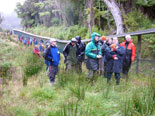 |
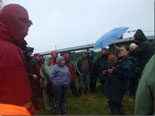 |
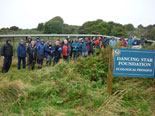 |
||
| Sern Conference along DSF fence |
Kari Beaven Speaks |
Field trip Sunday Afternoon |
||

